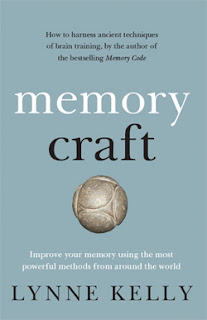 |
| A German Expressionist Squirrel from 1913 |
Although LK distinguishes between the visual alphabet for short term lists and the memory palace for things you want to keep, I'm doing it differently. Maybe I only need to do this while I'm getting familiar with the ensemble. Using the alphabet like a strip of tape on which I'm sketching something, and then transferring it, beast and all, onto a memory space.
I tried that by accident with the kids and the 12 books. I used the 12 animals to connect the books, then I laid the series around the room with the animals and the books together. It seemed like a not-bad way to get some familiarity with the alphabet creatures. I don't have many 26 item long lists. I'm wondering if you always need to start at A. I'm not very successful at remembering them with no content. If the content gets glued into the alphabet, I think it doesn't really matter. They can just hang out. I think if it turns out over complicated, then the Alphabet Creatures will drop out of their own accord.
 |
| A Roman Eagle from 1-2CE (Found UK) |
So with Janet really interested in creating her own alphabet but also having no idea what she might want to remember short term, we decided to find a list of things or a timeline of sorts that could be stuffed or stretched into 26 items. Something that would be useful in her world. She's in a transition point just now, at the end of secondary school and applying for future courses without being sure that's where she wants to go. So we picked the history of contemporary art. Even if she changes her mind about tertiary studies in fine arts, she's always going to be interested. Her school, like my tertiary art school, is very conceptual and experiential. They don't drill the canon, they're not prescriptive. So she picked that. A canon of Euro art. We googled around and found many versions of a very dodgy inadequate Eurocentric timeline of art that moves 8.000 years in 4 steps, has a category called 'Indian/Chinese/Japanese' and then rest is 20thC Euro art. But never mind, we need something rough to start with and it's something that will be helpful when browsing galleries.
 |
| A Cubist Faun from 1939 |
Then we started matching creatures with our arbitrary art schools and then the fun started. The dwarf and the eagle who were going off to Greece to study philosophy (In the Wednesday timetable experiment) are in the positions for Greek and Roman art. The Eagle is Roman. As we went along, we decided to pick a key artwork for the early art and a key artist/artwork for the later art. While trying to make associations for Mr Tumnus, we googled 'cubist faun' and what do you know (I feel I should have known), Picasso drew a LOT of fauns, some of them cubist. We found a German expressionist painting called 'Forest with squirrel'. We found an Op-Art Wolf. And so on. Just laughing and connecting.
I'm not sure how to get the dates in there with the styles. It's not a linear list. Some are spaced by thousands of years, then the last ones all overlap. Having strong visual associations with the name of the movement and the representative artwork is a great start, and as we read about them, it's a study session with a purpose.
 |
| Some Surrealist Unicorns from 1940s |
One possibility is that Janet tries to draw her final tableau with each creature in a different art style. That may be a terrible idea, but we're still drafting and terrible ideas are ok.
One of the things that's turning out fun in this project is that there is no right or wrong. Either it works, and I try it again, or it doesn't work and that's worth making a note.
Oh, something I'm not sure I mentioned before. When Janet brought back her completed first study for the Visual/ Animacy Alphabet, she talked me through it and the narrative that ran from one to the other was just fantastic. It clearly really engages her creative intelligence. Or resources. Whatever one should call that.
 |
| Janet Narrating her Animate Narrative Alphabet |








Comments
Post a Comment